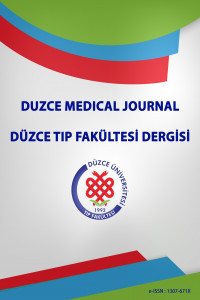Migrende Basagrisini Tetikleyici Ve Kötülestirici Faktörler
Migren, atak, tetikleyen ve kötülestiren faktörler
Precipitating and Aggravating Factors In Migraine Attack
Migraine, attack, precipitating and aggravating factors,
___
- Siniatchkin M, Averkina N, Gerber WD: Relationship Between Precipitating Agents and Neurophysiological Abnormalities in Migraine. Cephalalgia 26: 457-465, 2006.
- Zarifoglu M, Siva A, Hayran O and Turkish Headache Epidemiology Study Group: An Epidemiologic Study of Headache in Turkey: A Nationwide SSurvey. Neurology. 50 (Suppl. 4): A225, 1998.
- Börü ÜT, Koçer A, Lüleci a, Sur H, Tutkan H, Atli H: Prevalence and Characteristics of Migraine in Women of Reproductive Age in Istanbul, Turkey: A Population Based Survey. Tohoku J. Exp. Med 206: 51-59, 2005.
- Ferrari MD: Migraine. Lancet 351: 1043- 1051, 1998.
- Spierings ELH, Ranke AH, Honkoop PC: Precipitating and Aggravating Factors of Migraine versus Tension-type Headache. Headache 41: 554-558, 2001.
- Zivadinov R, Willeim K, Sepic -Grahovac D, Jurjevic A, Bucuk M, Brnabic -Razmilic O, Relja G, Zorzon M: Migraine and Tension-type Headache in Croatia: A Population-based Survey of Precipitating Factors. Cephalalgia 23: 336-343, 2003.
- Headache Classification Subcommittee of the International Headache Society, The International Classification of Headache Disorders: 2nd edition. Cephalalgia 24 (suppl 1): 9-160, 2004.
- Karli N, Zarifoglu M, Calisir N, Akgoz S: Comparison of Pre-headache Phases and Trigger Factors of Migraine and Episodic Tension-type Headache: Do They Share Similar Cephalalgia 25: 444-451, 2005. Pathophysiology?
- Chabriat H, Danchot J, Michel P, Joire JE, Henry P: Precipitating Headache. A Prospective Study in a National Migraineurs and Headache 39: 335-338, 1999. Factors of Control-matched Survey in Nonmigraineurs.
- Robbins L: Precipitating Factors in Migraine: A Retrospective Review of 494 Patients. Headache 43: 214-216, 1994.
- Nicolodi M, Sicuteri F: Wine and Migraine: Incompatibility? Drugs Exptl. Clin. Res XXV(2/3) : 147-153, 1999.
- Peatfield RC: Relationships between Food, Wine and Beer Precipitated Migrainous Headaches. Headache 35: 355-357, 1995.
- Savi L, Rainero I, Valfre W, Gentile S, Lo Giudice R, Pinessi: Food and Headache Attacks: A Comparison of Patients with Migraine and Tension-type Headache. Panminerva Med 44: 27-31, 2002.
- Fragoso YD, Carvalho R, Ferrero F, Lourenco DM, Paulino ER: Crying as a Precipitating Factor for Migraine and Tension-type Headache. Sao Paulo Med J/ Rev Paul Med 121: 31-33, 2003.
- Yayın Aralığı: 3
- Başlangıç: 1999
- Yayıncı: Düzce Üniversitesi Tıp Fakültesi
Üç Kiz Çocukta Hipohidrotik Ektodermal Displazi
Ozan BALAKAN, Veysel KIDIR, Ali SÜNER, Kendal YALÇIN
Hakan UZUN, Ahmet HAZNEDAROGLU, Nese ERSÖZYAR, Dursun Ali SENSES, Kenan KOCABAY
Diyarbakir Ilinde Meydana Gelen Trafik Kazalarinin Incelenmesi
İsmail Hamdi KARA, Karanfil SITMAPINAR, Özgür ERDEM, Metin KAPLAN, Mustafa ALDEMIR
Interferon Tedavisi Ile Basarili Bir Sekilde Tedavi Edilen Bir Kabakulak Orsiepididimit Olgusu
Hastane Personelinde Fekal Vankomisin Dirençli Enterokok Kolonizasyonunun Arastirilmasi
Mustafa YILDIRIM, İrfan SENCAN, Sükrü ÖKSÜZ
Inme Sonrasi Gelisen Ilaca Dirençli Jeneralize Nöbetlerde Gabapentin: Olgu sunumu
Abdulkadir KOÇER, Selçuk ATAKAY, Mehmet ERYILMAZ, Süber DIKICI
H Kamil ÇAM, M Ali KAYIKÇI, R Yavuz AKMAN
Migrende Basagrisini Tetikleyici Ve Kötülestirici Faktörler
Mehmet YAMAN, Mehmet Kemal DEMIRKIRAN, Serdar ORUÇ
Hipotiroidizm Ve Galaktoreli Bir Olguda Yalanci Hipofiz Kitlesinin Medikal Tedavi Ile Regresyonu
